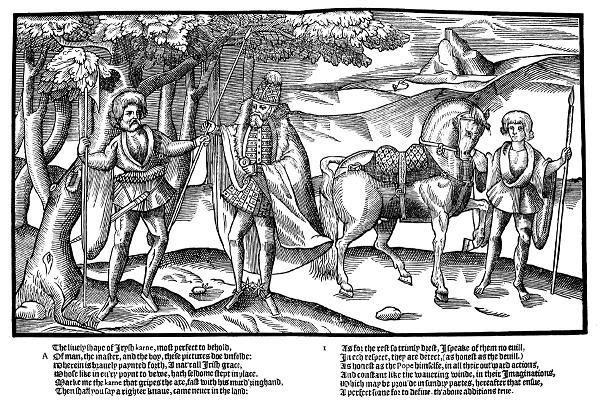
Originally Posted by
figheadair

Sorry, I meant that I think both are inaccurate, over romanticised representations of Irish Dress.

Peter, I understand & agree with your assesment that the first illustration was an "inaccurate, over romanticised representations of Irish Dress", but I'm curious why you consider the above woodcut to also be inaccurate & over romanticised?
Is it because John Derricke was English?
(I'm just curious.)
From Ospery Publishings "The Irish wars 1485-1603" (Man-At-Arms Series #256) by Ian Heath a brief history/description of the woodcuts:
"The best depictions of Irish warfare in the Tudor period are the series of 12 woodcuts to be found in 'Derricke's The Image of Ireland', published in 1581 but portraying events during Sir Henry Sidney's second viceroyalty, 1575-78 --probably his itinerary round Ireland from October 1575 to April 1576."
From what I read a few years ago from varied historical sources, there is speculation that Derricke was a retainer to Sir Henry Sidney & was an eyewitness to the events in Ireland during this period.
In a correspondence I had with Brian Donovan CEO, Eneclann Ltd./Archive CD Books Ireland, Trinity College Dublin (Ireland) back in March 2007 regarding these woodcuts, he said:
"There has been much debate in Ireland about Derricke's wood cuts. They are extremely valuable works, but have been sometimes taken out of context. Derricke's main interest was to record what Ireland was like in the context of Sir Henry Sidney (the Lord Deputy of Ireland) and his very military campaign against Gaelic rebels.
So most of his wood cuts show military activity, and Sidney being hailed as the saviour of the country in Dublin, by throngs of adoring public. The truth is that Sidney's regime was very unpopular in Ireland, even among the Anglo-Irish (or descendents of the Anglo-Norman settlers)."
When I conducted further digging (shortly after the above correspondence) on John Derricke I found that historians are universal in their opinion that the poetry found in his book:
"has long been considered a conventional attack on Irish barbarism, influenced by an increasingly brutal form of English colonialism, and intended to justify the mistreatment of Ireland's native population. Despite the low opinion critics have awarded its verse, the book occupies a key position in the literature depicting
sixteenth-century Ireland, recognized by a leading authority as "one of the most influential Elizabethan books on Ireland."
However, by the same token these same historians see the artwork (woodcuts) of the Irish in Derricke's book as "fascinating" / "historically accurate" /& "the best example of Irish warfare from the Tudor period".
Last edited by BoldHighlander; 13th January 11 at 02:20 AM.
[SIZE="2"][FONT="Georgia"][COLOR="DarkGreen"][B][I]T. E. ("TERRY") HOLMES[/I][/B][/COLOR][/FONT][/SIZE]
[SIZE="1"][FONT="Georgia"][COLOR="DarkGreen"][B][I]proud descendant of the McReynolds/MacRanalds of Ulster & Keppoch, Somerled & Robert the Bruce.[/SIZE]
[SIZE="1"]"Ah, here comes the Bold Highlander. No @rse in his breeks but too proud to tug his forelock..." Rob Roy (1995)[/I][/B][/COLOR][/FONT][/SIZE]
















Bookmarks